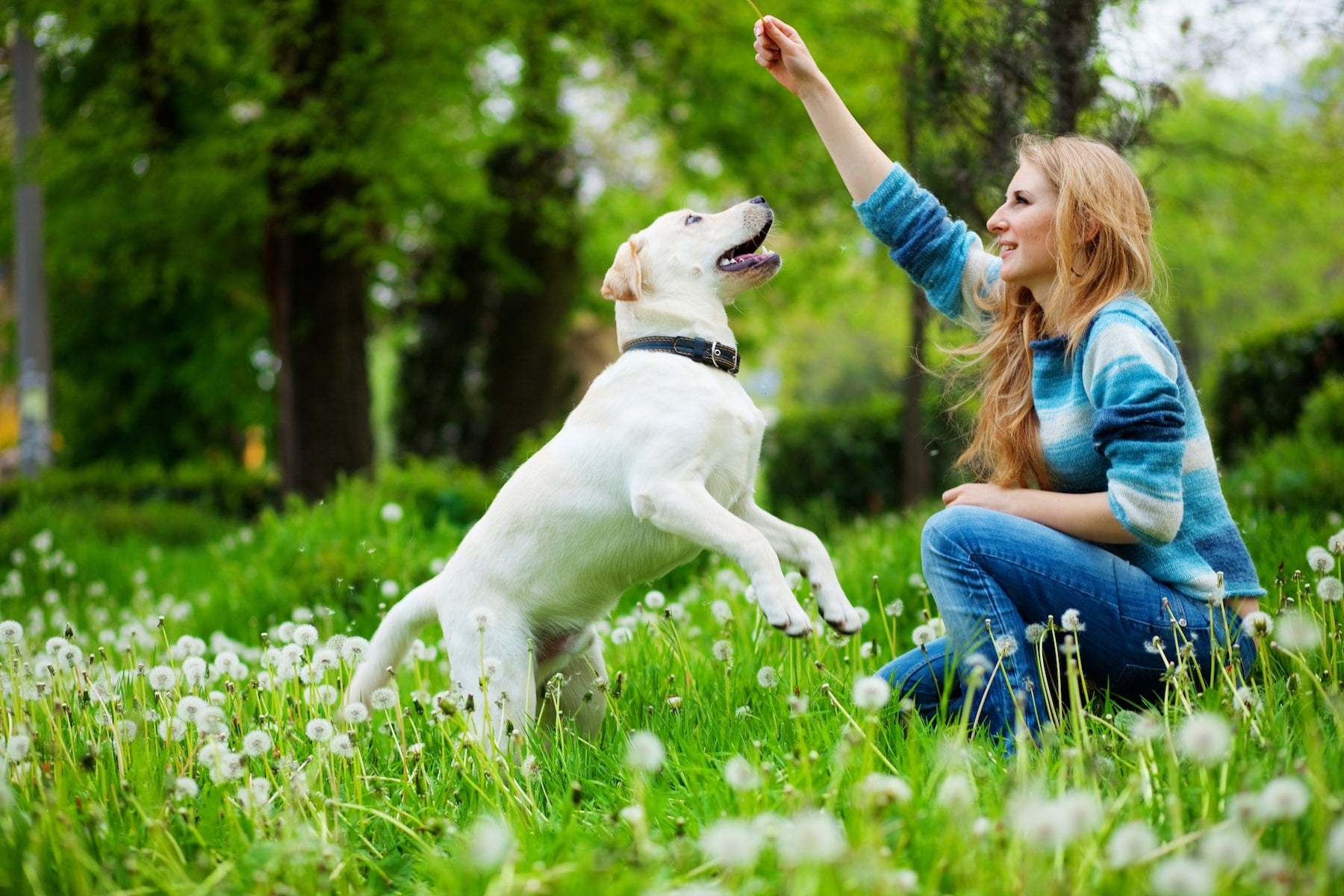
Here at Lolahemp, we are a Pets Before Profits company with a strong commitment to animal welfare. As part of our mission, we partner with various rescue organizations working hard to rescue dogs from euthanasia and find forever homes for at-risk dogs.
We believe that providing dog owners with the tools to train dogs through positive reinforcement methods helps build stronger bonds with pups, solve behavioral problems, and create loving, permanent homes.
This article is part of Lolahemp’s training series, exploring tips and tricks for training our canine companions. Preparation is one dog training principle that makes lessons more effective, from basic manners to fancy tricks.
So, let’s explore some tips on training a dog.
Why Proper Training is So Important
Let’s look at a few reasons why training your dog is so important.
Builds Confidence
Every time your dog is rewarded, it boosts their confidence. More success leads to more confidence and vice versa.
An important note to make here is that outdated paradigms of dog training, such as the so-called “dominance model,” suggest that if a dog perceives themselves to be “alpha,” they are actually dangerous and impossible to train. Such models often use intimidation, punishment, and force to get canines to “submit.”
Unfortunately for these dogs, confidence is often misunderstood as “alpha” behavior. Learning gets confused with submission (they are not the same thing!).
It is important to understand that dogs who are trained with fear-based methods are actually more likely to develop problem behaviors like aggression and anxiety. And, understandably, they tend to dread learning.
Modern positive reinforcement-based methods focus on building confidence. A confident dog is more balanced under stress and less likely to lash out in fear.
Confident dogs are also more likely to volunteer behaviors during a training session. For trainers looking to teach fancy tricks, this is a vital personality trait to cultivate as it makes techniques such as capturing and shaping much more productive.

Cultivates Motivation and Drive to Train
Setting your dog up for success during training sessions helps to associate learning with good stuff for your dog. Dogs, like people, seek out good things. When your training sessions become associated with rewards, then your dog is going to be completely stoked to learn that next great thing.
Contributes to Faster Learning
Dogs who are motivated have better focus and drive to train. It is a myth that some dogs are just dumb or too headstrong to learn. Most dogs just need to learn that learning is fun. Setting your dog up for success is the key to making that happen.
Fundamental Dog Training Tips
How to Set Your Dog Up For Success:
- Manage the environment - no distractions!
- Use a high rate of reward
- Set appropriate reward criteria
- Ignore unwanted behaviors
- End the session before your dog quits
Manage the Environment
The first step is to manage the environment. It is your responsibility as a trainer to make sure your training takes place in an environment where rewards and small treats are the key focus. You have removed any distractions that keep your dog from staying laser-focused on you during a training session.
This is key for training new behaviors. For example, if you’re training your dog to sit and stay, doing your initial training sessions in the living room is probably better than in the back yard where sights and smells can be a major distraction.
However, once your dog is reliably sitting and staying in a “no distraction” environment, you can start to add distractions (such as going in the backyard or even going into a public place) to prove the behavior under those conditions.
Managing the environment is also the first step in addressing most problem behaviors such as problem barking or dog aggression. The key to working with your dog is to try to eliminate any triggers for unwanted behaviors first to eliminate the problem behavior, then introduce them slowly while rewarding good behavior in the face of a diluted trigger.

Understanding Rate of Reward
The rate of reward is simply how often you reward relative to time. When training a brand new behavior, pro dog trainers look to have a rate of reward every 3-10 seconds.
Let that sink in. That means you are marking and rewarding every 3-10 seconds. This is one of the biggest differences between professional dog trainers and novices.
The faster your reward rate, the more intense focus you will build with your dog, and, the faster they will “get” what you are looking for. Think of it as “success” on steroids. Give it a try and see how fast your dog learns that next trick!
Set Appropriate Criteria
One of the most important principles in the training process is to have complete control over the rate of reward. That’s right! Rate of reward has nothing to do with how smart your dog is...it has everything to do with how smart you are!
The trick is to understand how to set and change the reward criteria. The reward criteria is that behavior you are looking for to earn your dog a mark (either the clicker or a special reward marker word such as Yes!) followed by a reward.
You have complete control over what reward criteria you use, and it will change as you train. Think of it as setting a bar for success in obedience training. Set the bar too high and your reward rate will go below the ideal rate. That’s when you know you have to lower the bar in order to set your dog up for success.
Here is an example. Let’s say your dog already has “Sit” down pat and you are now teaching her to “Stay.” At first, you will set the criteria as 2-3 seconds of a stay while you are standing still in front of her. Once she is doing that reliably, say 90% of the time she is getting that mark and reward, then you raise the criteria. Now she needs to stay for 2-3 while you take a step in any direction.
If she is successful at that 2-3 seconds of staying while you are moving, keep rewarding that at a high rate. If she starts to fail, then lower the criteria back to the last step and keep that rate of reward up. Or, try making a smaller movement to lower the criteria at first, upping the ante only as long as you are able to keep up a high rate of reward.
Using this process of adjusting the criteria to your dog’s ability to be successful may sound tedious. However, in the long run it pays big dividends in terms of results.
Once your dog has some confidence with the initial behavior, you can start to lower the rate of reward. Just keep an eye on their motivation and focus. If it starts to slip, you are probably going too long between rewards and need to set different criteria.
Ignore Unwanted Behaviors
A lot of people make the mistake of using punishment during a dog training session. Frankly put, punishment has no place in a dog training session. Instead, just ignore unwanted behaviors and focus on rewarding the behaviors you are looking for at the criteria that you have set. Eventually, unwanted behaviors that are ignored will disappear because they will be crowded out by the right behaviors that are regularly rewarded.
This is not to say that well-timed and humane punishment (such as a “time out”) is never appropriate in the larger scheme of things. For example, dangerous behavior such as chewing on electrical chords needs a prompt and swift reaction to humane punishment. However, during a training session you have already managed the environment….so dangerous behaviors that require punishment should not even be an issue.

Punishment during a training session runs the very real risk of your dog associating training with risk and a lack of safety. This will cause them to shut down, turn off, and try to avoid engaging with you - the opposite of what you are looking for.
Some dog trainers do use a negative marker, sparingly, when training. Something like “Too bad!” and making a big deal about NOT rewarding the dog or walking away from the training session, as a form of punishment. This kind of negative punishment can be effective, particularly when proofing already learned dog behaviors. However, it isn’t a good idea when training new behaviors.
End a Training Session Before Your Dog Quits
Finally, a big key to making your training sessions effective is to end the training session before your dog is ready to. Always leave them wanting more. Pay attention to how long your dog stays focused during training, and end the session before they start to get mentally tired.
You can also add potty breaks if your dog is starting to ignore your basic commands. Training your puppy means recognizing the length of their attention span. The sooner you start training, the sooner their attention span will get larger.
The good news is that by following this rule for setting your dog up for success, you will find that your pooch builds up focus and motivation over time, allowing you to have longer and more effective sessions over time.
References:
https://lolahemp.com/pages/community
https://lolahemp.com/blogs/news/cbd-oil-dog-aggression
https://lolahemp.com/blogs/news/how-to-stop-my-dog-from-barking-training-tips

